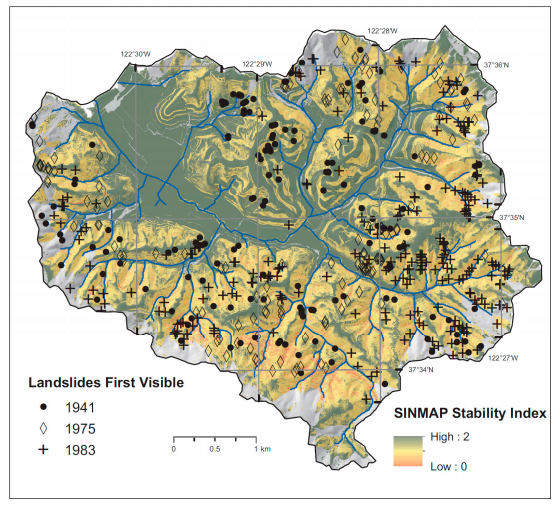A hybrid physical and maximum-entropy landslide susceptibility model

Davis, Jerry, and Leonhard Blesius. "A Hybrid Physical and Maximum-Entropy Landslide Susceptibility Model." 17.6 (2015): 4271-4292.
The clear need for accurate landslide susceptibility mapping has led to multiple approaches. Physical models are easily interpreted and have high predictive capabilities but rely on spatially explicit and accurate parameterization, which is commonly not possible. Statistical methods can include other factors influencing slope stability such as distance to roads, but rely on good landslide inventories. The maximum entropy (MaxEnt) model has been widely and successfully used in species distribution mapping, because data on absence are often uncertain. Similarly, knowledge about the absence of landslides is often limited due to mapping scale or methodology. In this paper a hybrid approach is described that combines the physically-based landslide susceptibility model ‘Stability INdex MAPping’ (SINMAP) with MaxEnt. This method is tested in a coastal watershed in Pacifica, CA, USA, with a well-documented landslide history including 3 inventories of 154 scars on 1941 imagery, 142 in 1975, and 253 in 1983. Results indicate that SINMAP alone overestimated susceptibility due to insufficient data on root cohesion. Models were compared using SINMAP stability index (SI) or slope alone, and SI or slope in combination with other environmental factors: curvature, a 50-m trail buffer, vegetation, and geology. For 1941 and 1975, using slope alone was similar to using SI alone; however in 1983 SI alone creates an Areas Under the receiver operator Curve (AUC) of 0.785, compared with 0.749 for slope alone. In maximum-entropy models created using all environmental factors, the stability index (SI) from SINMAP represented the greatest contributions in all three years (1941: 48.1%; 1975: 35.3; and 1983: 48%), with AUC of 0.795, 0822, and 0.859, respectively; however; using slope instead of SI created similar overall AUC values, likely due to the combined effect with plan curvature indicating focused hydrologic inputs and vegetation identifying the effect of root cohesion. The combined approach––using either stability index or slope––highlights the importance of additional environmental variables in modeling landslide initiation.
Keywords: landslide susceptibility; maximum entropy model; physical model;
hybrid model; cohesion